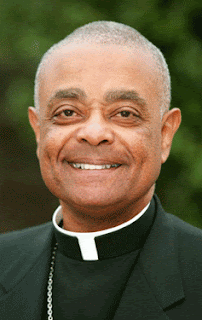To Be a Saint
 Ask anyone who's been to Los Angeles' Cathedral of Our Lady of the Angels, and odds are they'll tell you that the most striking feature of the place is John Nava's tapestry portrayal of "The Communion of Saints."
Ask anyone who's been to Los Angeles' Cathedral of Our Lady of the Angels, and odds are they'll tell you that the most striking feature of the place is John Nava's tapestry portrayal of "The Communion of Saints."More than just sometimes, you'll hear of folks -- even of the not-normally-emotional type -- who've wept at the sight of the simple figures, shown walking together toward the altar.
And why the tears? Most common answer: something along the lines of "they look normal... they look like us."
...because "us" is what they are, and they're what we're called to be.
On this All Saints Day, big tip to our good friend Greg Kandra -- first-year deacon, long-time journo, author of The Deacon's Bench -- whose homily for the feast is snipped below.
Shortly after he converted to Catholicism in the late 1930s, Thomas Merton was walking the streets of New York with his friend, Robert Lax. Lax was Jewish, and he asked Merton what he wanted to be, now that he was Catholic.
“I don’t know,” Merton replied, adding simply that he wanted to be a good Catholic.
Lax stopped him in his tracks.
“What you should say,” he told him, “is that you want to be a saint!”
Merton was dumbfounded.
 “How do you expect me to become a saint?,” Merton asked him.
“How do you expect me to become a saint?,” Merton asked him.Lax said: “All that is necessary to be a saint is to want to be one. Don’t you believe that God will make you what He created you to be, if you will consent to let him do it? All you have to do is desire it.”...
Thomas Merton knew his friend was right. Merton, of course, would go on to become one of the great spiritual thinkers and writers of the last century. His friend Bob Lax would later convert to Catholicism himself -- and begin his own journey to try and be a saint.
But the words Lax spoke ring down through the decades to all of us today. Because they speak so simply and profoundly to our calling as Catholic Christians.
You should want to be a saint. And to be one, all you need is to want to be one.
Of course, if you only want to be a run-of-the-mill, average Christian, that’s probably all you’ll ever be. Every one can do just enough to get by. It’s not hard.
But the message Christ sends to all of us is an invitation to be something more. In the words of the old Army recruiting ad: be all that you can be....
Most of us are familiar with the phenomenal saintly stories of the Church. We grew up hearing of how John was beheaded, and Stephen
 was stoned; how Francis got the stigmata, or how Therese suffered humiliations and disease to die an early death. You hear stories like that and you can’t blame Thomas Merton for not really being eager to be a saint. It’s not only hard work, it often doesn’t have a happy ending.
was stoned; how Francis got the stigmata, or how Therese suffered humiliations and disease to die an early death. You hear stories like that and you can’t blame Thomas Merton for not really being eager to be a saint. It’s not only hard work, it often doesn’t have a happy ending.But those are the stories we hear about. There are countless stories – millions, throughout the centuries – that we don’t. They are the anonymous saints who go about their daily lives quietly, peacefully, joyfully, finally entering into the fullness of grace without doing anything more dramatic than merely living the beatitudes.
They are the unsung saints.
If you visit the Cathedral of Our Lady of the Angels in Los Angeles, you’ll see magnificent tapestries lining the walls. And they really are magnificent, designed and executed by the artist John Nava. They remind me of the work of Norman Rockwell or Andrew Wyeth – dramatic, realistic, and contemporary depictions of ordinary people of extraordinary character. And they adorn the walls of the cathedral the same way that stained glass windows once decorated the great Gothic cathedrals of Europe.
In the tapestries, you can see all the familiar saints whose names we know, in a row, facing toward the altar, as if in line for communion. It is – literally and figuratively – the communion of the saints. There is St. Nicholas, St. Gregory, St. Thomas Aquinas, St. Francis, St. Clare…and on and on, with their names over their heads.
But scattered among those saints are people without names – people you won’t find in Butler’s
 “Lives of the Saints.” A teenage girl. A young man from the barrio. Children in contemporary clothes. They are the saints whose names are known only to God. It is a beautiful and eloquent depiction of the day we celebrate today: All Saints.
“Lives of the Saints.” A teenage girl. A young man from the barrio. Children in contemporary clothes. They are the saints whose names are known only to God. It is a beautiful and eloquent depiction of the day we celebrate today: All Saints.And the message of those tapestries is the message of this feast day: these unknown saints are just as worthy as they ones who are known. They look like us. They look like people we might pass on the street. If they can be holy, can’t we all?
What does it take to join them?
As Bob Lax explained, to a man whom some people today consider a saint:
All you really need… is to want to.
And God will do all the rest.
PHOTOS: Property John Nava/Archdiocese of Los Angeles
-30-











